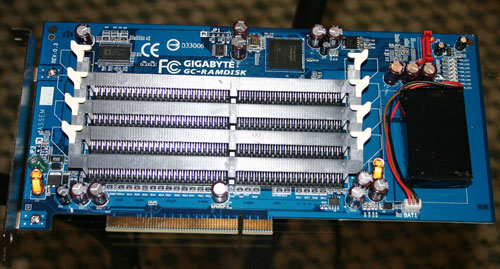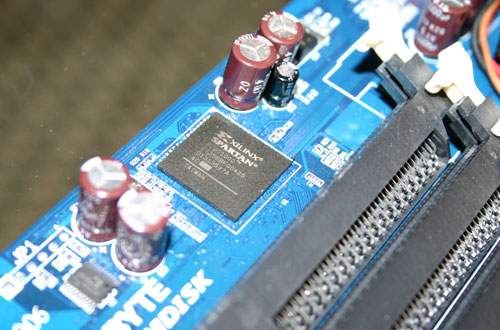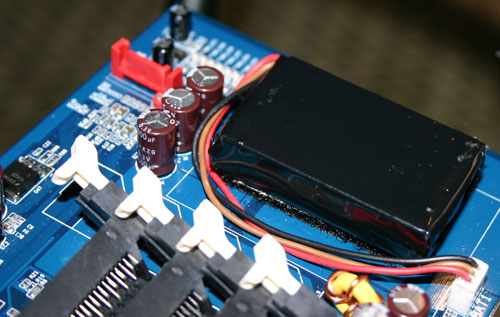Computex 2005 Early Bird Coverage: NVIDIA's G70, Athlon 64 BTX and more
by Anand Lal Shimpi on May 30, 2005 8:53 AM EST- Posted in
- Trade Shows
Gigabyte Brings Solid State Storage to the Mainstream
In an effort to differentiate themselves from other motherboard manufacturers, Gigabyte has introduced a number of interesting add-ons for their motherboards, the most interesting of which is their $50 RAMDISK PCI card.

The card is a regular 32-bit PCI card that features four standard DIMM slots on board. The card also features a custom Gigabyte FPGA that is programmed to act as a SATA to DDR translator, which convinces the SATA controller you connect the card to that the memory you have on that card is no different than a regular SATA HDD. As long as you have memory on the card, the card will be available at POST as an actual SATA drive, with no additional drivers necessary.

The Custom Gigabyte FPGA
The card is powered via the PCI slot, but RAM is volatile and thus if no power is provided to the card then all of the data is lost. In order to make this solution more realistic for real-world usage, Gigabyte outfitted the card with a rechargeable battery pack that can keep the memory powered and data intact for up to 16 hours with no power. After that 16 hours is up, your data is lost, but as soon as you apply power to the card again the battery pack will begin to recharge.

The Battery Pack and SATA connector. You connect a SATA cable from this port to the SATA controller on your motherboard and the RAMDISK will be treated as a hard drive.
Given that the card offers no real backup other than the battery it’s not really suitable for extremely sensitive data, but it works well if your system is on all the time. Obviously the biggest benefit of using DDR memory as storage is that all accesses occur in nanoseconds, not milliseconds and is thus much faster at random accesses than regular hard drives. Transfer rates are also improved, but you're limited by the bandwidth of the SATA interface so DDR200 memory is the fastest that is supported.
It is an interesting step for Gigabyte, and we’d like to see how the technology evolves over time.










80 Comments
View All Comments
dmctaggart - Thursday, July 14, 2005 - link
BTW where is the $50 ram card?Anandtech says:
Prices
Newegg.com $88.00
Amazon Marketplace $91.54
Monarch Computer Systems $87.00
dmctaggart - Thursday, July 14, 2005 - link
Since when do you need hardware to have a ramdrive?Hookup a ups to a ram drive? Why not just hook it up to your computer if you don't want to lose the ramdrive?
Buy the slowest ram you can for your hardware swap drive?
Why not have a ramdrive using the fast ram you have installed on your computer and aim your swapdrive at it?
I think everyone has gone buggy.
Danno
flloyd - Thursday, June 2, 2005 - link
Accroding to this article, the PCI slot powers it up while the computer is off and therefore the battery is only for when it is unplugged or during a power outage.http://www.infoworld.com/article/05/06/01/HNxpwind...
drag0n - Thursday, June 2, 2005 - link
how about this:1-set your PC to boot off SATA first as in:
no OS goto harddrive
OS goto SATA ramdisk
2-mirror your xp install to your 4G ramdisk
3-reboot
4-configured for ALL OS functions running off the SATA ramdisk (including swapfile, temps, etc.)
5-never leave your PC off for more than 16 hrs.
*grin*
MrHaze - Thursday, June 2, 2005 - link
I'd really like to run the Gigabyte ramdisk for my pagefile.The key factor would be finding slow (cheap) RAM.
My thoughts on more system memory vs. ramdisk:
Yeah, more system memory is obviously better. But with system memory you're trying to milk every bit of speed you can--and that's expensive. Most folks top out around 2gb or even 1gb. 4Gb is troublesome.
It seems that a cheap 2-4 gb ramdisk for the pagefile would be an excellent addition to 2Gb of system memory.
Question:
Why don't DIMM manufacturers make something like this? Seems like they could build a big PCB with 4+ gb of appropriate and cheap RAM chips (instead of whole DDR DIMMS designed for a completely different application). One big-ass memory module. Wouldn't this be a more elegant and cost-effective solution?
Mr. Hayes
myne1 - Wednesday, June 1, 2005 - link
Actually, nevermind my last comment.This is an absolutely awesome way of doing it.
Gigabyte; please pat your engineers on the back.
Any word on eta/avaliability?
I want one now! Now as in yesterday :D
myne1 - Wednesday, June 1, 2005 - link
WOW!2 months ago I posted my ideas about a PCI-E based RAM card on OCAU and a couple of other forums. I even emailed a couple of big-name companies, but not gigabyte. My mistake it seems :/
(link to my post : http://forums.overclockers.com.au/showthread.php?t...
The concept drawing is crude, but I still hope that someone makes it. Even in 1x mode it'll have nearly 4x the bi-directional bandwith of PCI.
http://www.users.on.net/~jvizard/myne/RAMcard.JPG
Gigabyte, if you're reading this, pretty please :)
EODetroit - Wednesday, June 1, 2005 - link
Because you can buy cheap ram for the board, and it won't hurt performance. The limiting factor will be the sata connection, not the ram speed.Whereas there's problems with 4GB of system memory, such as many OS' not liking that much, many motherboards not supporting that much, and if you want to run at DDR400 you're going to have to buy expensive ram.
Also some of that system memory would have to go towards the system and not the ram disk... in the end you'll probably max out at a 3GB ram disk or so. And finally with the add-in boards you could raid two of them together to create ram disks > 4GB in size, which would otherwise be impossible since no ram disk software seems to support sizes over 4GB, at least on Windows.
oupei - Wednesday, June 1, 2005 - link
If you're willing to buy 4gb of ram to put on the ramdrive, why not just put it on the mobo and just have 4gb of ram?unless you want it for startup, i don't see why anyone would want it.
justly - Tuesday, May 31, 2005 - link
Also, thanks for the URL. I haven't read it yet (SFF is not a priority for me) but I will make sure to read it. thanks again.